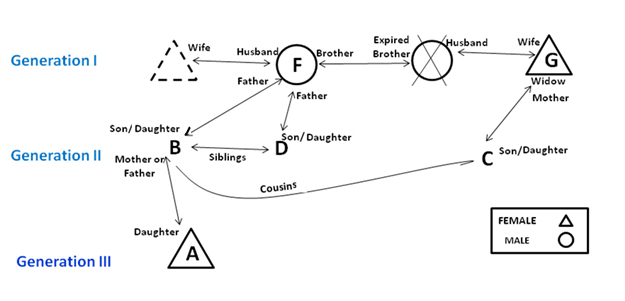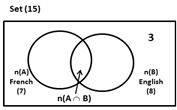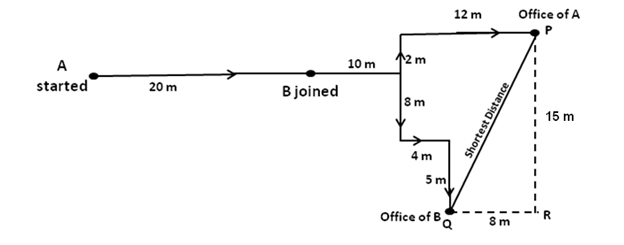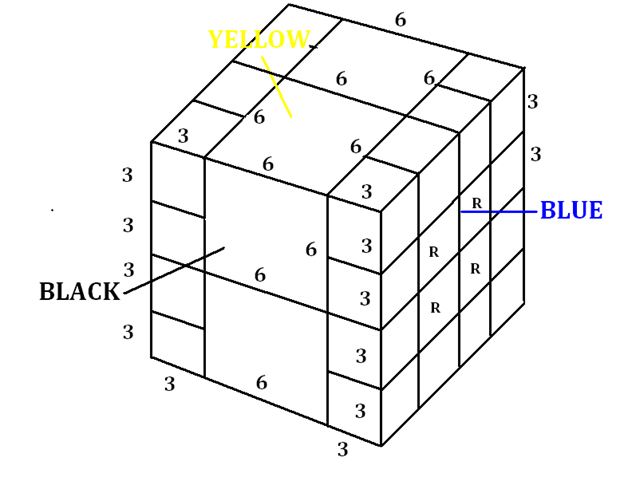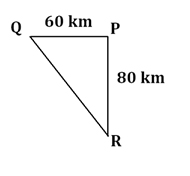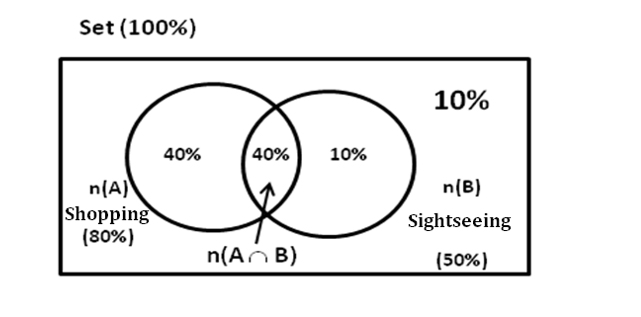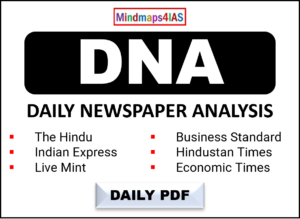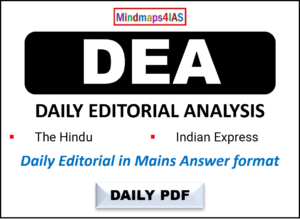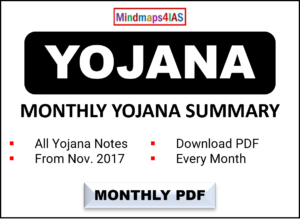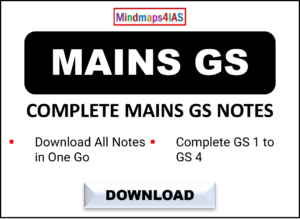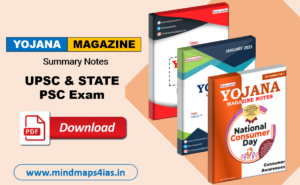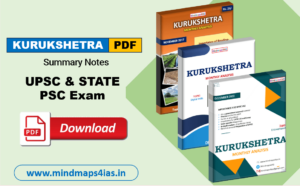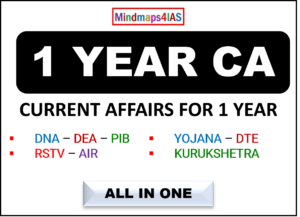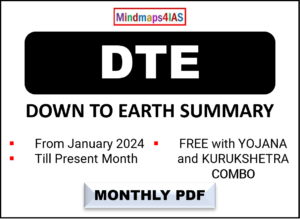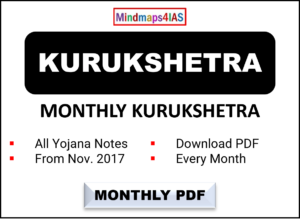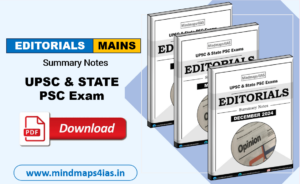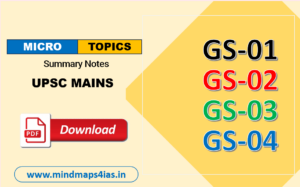|
Questions |
Answer + Explanation |
|
1. If every alternative letter of the English alphabet from B onwards (including B) is written in lower case (small letters) and the remaining letters are capitalized, then how is the first month of the second half of the year written?
|
Sol. Answer is (d). If we will write the English alphabet as described in the question we will get the 26 letters as – AbCdEfGhIjKlMnOpQrStUvWxYz. So, July will be written jUlY.
To do this mentally, break up the 26 alphabets into 13 pairs of two alphabets each – ab, cd, ef, ….. yz. Then, mentally visualize them to become – Ab, Cd, Ef, ….. Yz. Then July will have y at the end. That is capital Y. So options (b) and (c) are ruled out. And alphabet j will be in small caps. So (a) is ruled out. So answer is option (d). |
|
2. Sunita cuts a sheet of paper into three pieces. Length of first piece is equal to the average of the three single digit odd prime numbers. Length of the second piece is equal to that of the first plus one-third the length of the third. The third piece is as long as the other two pieces together. The length of the original sheet of paper is
|
Sol. Answer is (d). The only three single digit odd prime numbers are 3, 5 and 7. So the length of the first piece = (3+ 5 + 7)/3 = 5. Now let the length of the second piece = X units.
Then by the condition given in question we have – Length of the third piece = X + 5. Length of the second piece = X = 5 + (X + 5)/3. Solve this to get X = 10. So, length of the first piece = 5, second piece = 10 and third piece = 15. So length of the original sheet = 5 + 10 + 15 = 30 units. Ans.(d) |
|
3. In the sequence 1, 5, 7, 3, 5, 7, 4, 3, 5, 7, how many such 5s are there which are not immediately preceded by 3 but are immediately followed by 7?
|
Sol. Answer is (a).In the given sequence 1, 5, 7, 3, 5, 7, 4, 3, 5, 7, there is only one such 5 that is not preceded immediately by 3, but immediately followed by 7. It is the one in bold – 1, 5, 7, 3, 5, 7, 4, 3, 5, 7. |
|
4. A joint family consists of seven members A, B, C, D, E, F and G with three females. G is a widow and sister-in-law of D’s father F. B and D are siblings and A is daughter of B. C is cousin of B. Who is E?
Select the correct answer using the code given below:
|
Sol. Answer is (d).All are correct – E is the wife of F, grandmother of A, and aunt of C. The information given in question can be interpreted by the diagram shown –
Hence answer is (d). |
|
5. Each face of a cube can be painted in black or white colours. In how many different ways can the cube be painted?
|
Sol. Answer is (b).There are many cases possible. Basic assumption is that all faces are identical and not identified by different numbers.
Case I: All the faces are painted black. ONE case. Case II: Five faces are painted black and one face is painted white. ONE case (Since cube is symmetrical figure on all its faces, that is why six cases will reduce to ONE) Case III:Four faces are painted black and two faces is painted white. Two cases. First when the two white faces are on opposite faces and second when the two white faces are on adjacent faces. Case IV: Three faces are painted black and three faces is painted white. Two cases. This can be done in two ways. Case V: Two faces are painted black and four faces is painted white. Similar to case III. Two cases. First when the two white faces are on opposite faces and second when the two white faces are on adjacent faces. Case VI: One face is painted black and five faces are painted white. Similar to case II. ONE case (Since cube is symmetrical figure on all its faces, that is why six cases will reduce to ONE) Case VII: All the faces are painted white. ONE case. So, total 1 + 1 + 2 + 2 + 2 + 1 + 1 = 10 cases are possible. A simpler way to look at it will be – 0 sides White : 1 way (all sides Black) 1 side White : 1 way (all other sides Black) 2 sides White : 2 ways (1 way with adjacent sides White, and 1 way with opposite sides White) 3 sides White : 2 ways (1 way where three White sides have same corner, and 1 way where opposite sides are White and one center side is White) 4 sides White : 2 ways (same as 2 sides Black) 5 sides White : 1 way (same as 1 side Black) 6 sides White : 1 way (same as 0 sides Black) So total=1+1+2+2+2+1+1 = 10 ways. |
|
6. How many triplets (x, y, z) satisfy the equation x + y + z = 6, where x, y and z are natural numbers?
|
Sol. Answer is (d). x, y and z are natural numbers. So, x, y and z will be greater than zero. It also means that minimum 1 will be there at all places in (x, y, z).
So we can conclude that x’ + y’ + z’ = 6 – (1 + 1 + 1) = 3, where x’, y’, and z’ can take value 0 too. Now this is a problem of distributing three objects at three places (i.e. with two partitions). This can be done in 5!/(3!×2!) = 10 ways. The other, simpler way to do it is to manually check. We get 10 sets of triplets : (1,2,3), (1,3,2), (2,1,3), (2,3,1), (3,1,2), (3,2,1),(1,1,4), (1,4,1), (4,1,1), (2,2,2). |
|
7. If $ means ‘divided by’; @ means ‘multiplied by’; # means ‘minus’, then the value of 10#5@1$5 is
|
Sol. Answer is (d). After changing the expression as per the conditions given in the question, we get 10#5@1$5 = 10 – 5 × 1 ÷ 5.
Using BODMAS, we first get 1 / 5 = 1/5. Then we get 5 x 1/5 = 1. Then we get 10 – 1 = 9. Hence, we have answer 9. Ans.(d) |
|
8. An 8-digit number 4252746B leaves remainder 0 when divided by 3. How many values of B are possible?
|
Sol. Answer is (c). This is a question based on rules of divisibility. The rule of divisibility of 3 is that the sum of all the digits of the number should be divisible by 3. We have 4 + 2 + 5 + 2 + 7 + 4 + 6 + B = 30 + B, which is completely divisible by three. So B can take value as 0, 3, 6, or 9. Hence 4 values are possible for B. Ans.(c) |
|
Directions for the following 3 (three) items: Read the following information and answer the three items that follow: Six students A, B, C, D, E and F appeared in several tests. Either C or F scores the highest. Whenever C scores the highest, then E scores the least. Whenever F scores the highest, B scores the least. In all the tests they got different marks; D scores higher than A, but they are close competitors; A scores higher than B; C scores higher than A. 9. If F stands second in the ranking, then the position of B is
10. If B scores the least, the rank of C will be
11. If E is ranked third, then which one of the following is correct?
|
Solution for Q. 9 to 11:
Let’s first number the conditions given in question. There are eight conditions in all. i. Six students A, B, C, D, E and F appeared in several tests. ii. Either C or F scores the highest. iii. Whenever C scores the highest, then E scores the least. iv. Whenever F scores the highest, B scores the least. v. In all the tests they got different marks; vi. D scores higher than A, but they are close competitors; vii. A scores higher than B; viii. C scores higher than A Sol 9. Answer is (c). If F stands second, then by condition (ii), C will be first. If C is first (i.e., score highest) by condition (iii), E scores the least. And using conditions v, vi, vii and viii, we got the following order – C – F – D – A – B – E. Hence B stood fifth. Sol 10. Answer is (d). B scores last means C is not on the first position (condition iii). So on the first position there must be F (condition ii). Now out of six positions first and last positions are fixed. F _ _ _ _ B. The middle four positions will be filled by E, C, D and A. In which C, D and A will come in following order (conditions v, vi, vii and viii) – F _ C _ D _ A _ B In this arrangement E can occupy four positions. In every case C can be either occupy second or third place. Ans.(d) Sol 11. Answer is (b). E is ranked third, it means it is not ranked last, it means C is not first, it means F is first, it means B is last (using conditions given in question). So we have following arrangement – F _ E _ _ B Now by using conditions v to viiii we have final order – F C E D A B Ans.(b) |
|
Directions for the following 2 (two) items: Read the following statements SI and S2 and answer the two items that follow: S1: Twice the weight of Sohan is less than the weight of Mohan or that of Rohan. S2: Twice the weight of Rohan is greater than the weight of Mohan or that of Sohan. 12. Which one of the following statements is correct?
13. Which one of the following statements is correct?
|
Solution for Q. 12 to 13:
Sol 12. Answer is (d). Let weight of Sohan = S, weight of Mohan = M and weight of Rohan = R. Then by the condition given we have : 2S < M, even double of S is less than M. So, S < M. 2S < R, even double of S is less than R. So S < R. So, we can conclude that S is less than M and R. But we do not know the order relation between M and R. Again, 2R > M, means either R = M or R > M or R < M. So we cannot conclude relation between R and M. 2R > S is obvious as we have concluded R > S above. So not give any fruitful information. Ans.(d) Sol 13. Answer is (b). It is clear that weight of Sohan is least. |
|
Directions for the following 7 (seven) items: Read the following five passages and answer the items that follow each passage. Your answers to these items should be based on the passages only. Passage — 1 India’s economic footprint, given its population, still remains small compared to the US, the European Union or China. It has much to learn from other economies, yet must implement solutions that fit its unique circumstances. India especially needs an effective long-term regulatory system based on collaboration rather than the ‘ current top-down approach. Regulations seek desirable outcomes yet are repeatedly used as political tools to push one agenda or another. Often, regulations fail to consider impacts on jobs and economic growth — or less restrictive alternatives. Regulations may be used to protect local markets at the expense of more widely shared prosperity in the future. Additionally, regulations inevitably result in numerous unintended consequences. In today’s hyper competitive global economy, regulations need to be viewed as “weapons” that seek cost-justified social and environmental benefits while improving the economic well-being of most citizens. 14. Which one of the following is the most logical, rational and crucial inference that can be derived from the above passage ?
15. On the basis of the above passage, the following assumptions have been made : In today’s global economy,
Which of the above assumptions is/are valid ?
|
Solution for Q. 14 to 15:
Sol 14. Answer is (a).Option (c) is not the main inference being drawn. It is one of the discussed issues, but that’s it. Option (d) is also one of the issues discussed, but not the main inference we can derive. Option (b) comes close to being the most logical inference, but option (a) is the best. Why? The passage started with the idea of economic size of India. Then it went on to discuss the problems of regulatory system(s) in India. So, (a) is better than (b). Sol 15. Answer is (a).The first assumption is valid (at least for India, as per the passage) because it is mentioned that “…regulations may be used to protect local markets at the expense of …”. So, regulations are not being used effectively, while being deployed to protect local markets. The second assumption seems wrong as the last part of the para tells us the opposite – governments focusing more on social and environmental concerns than economic ones (the balance is missing). So 2 is wrong. Hence 1 only (option (a)) seems correct. |
|
Passage — 2 In a study, scientists compared the microbiomes of poorly nourished and well nourished infants and young children. Gut microbes were isolated from faecal samples of malnourished and healthy children. The microbiome was “immature” and less diverse in malnourished children compared to the better developed “mature” microbiome found in healthy children of the same age. According to some studies, the chemical composition of mother’s milk has shown the presence of a modified sugar (sialylated oligosaccharides). This is not utilized by the baby for its own nutrition. However, the bacteria constituting the infant’s microbiome thrive on this sugar which serves as their food. Malnourished mothers have low levels of this sugar in their milk. Consequently, the microbiomes of their infants fail to mature. That in turn, leads to malnourished babies. 16. Which one of the following is the most logical, rational and crucial inference that can be derived from the above passage ?
17. On the basis of the above passage, the following assumptions have been made :
Which of the above assumptions is/are valid?
|
Solution for Q. 16 to 17:
Sol 16. Answer is (c). Option (a) is wrong. If the cause is found, treatment is possible. Option (b) seems too far-fetched, and is not mentioned anywhere (inoculation etc.) Option (a) is wrong. If the cause is found, treatment is possible. Option (b) seems too far-fetched, and is not mentioned anywhere (inoculation etc.) Option (c) sounds good, if it would be technically correct (that we do not know from the passage). The problem with it is “…instead of mother’s milk”. Option (d) also sounds correct. It is a logical, rational and crucial inference regarding policy choices to be made regarding nutrition etc. But the problem is that the passage has zero hint about “policy choices at government or administrative levels” to be made. It is a pure science-related passage only. Hence, we choose option (c) over (d). Sol 17. Answer is (c). Assumption 1 sounds correct as it will help make up for the early year problems due to improper nourishment via mother’s milk. Assumption 2 is clearly valid as seen in the passage (the last two sentences). |
|
Passage — 3 Temperatures have risen nearly five times as rapidly on the Western Antarctic Peninsula than the global average over the past five decades. Researchers have now found that melting glaciers are causing a loss of species diversity among benthos in the coastal waters off the Antarctic Peninsula, Impacting an entire seafloor ecosystem. They Believe increased levels of suspended sediment in water to be the cause of the dwindling biodiversity in the coastal region. 18. On the basis of the above passage, the following assumptions have been Made :
Which of the above assumptions is/are valid?
|
Sol. Answer is (c). All three assumptions seem to be valid. |
|
Passage — 4 A research team examined a long-term owl roost. Owls prey on small mammals and the excreted remains of those meals that accumulated over the time, provide us an insight into the composition and structure of small mammals over the past ‘millennia. The research suggested that when the Earth went through a period of rapid warming about 13,000 years ago, the small mammal community was stable and resilient. But, from the last quarter of the nineteenth century, human-made changes to the environment had caused an enormous drop in biomass and energy flow. This dramatic decline in energy flow means modern ecosystems are not adapting as easily as they did in the past. 19. On the basis of the above passage, the following assumptions have been made :
Which of the above assumptions is/are valid ?
|
Sol. Answer is (b). Assumption 1 cannot be made on the basis of this para, as only one example is cited. So options (a) and (d) are ruled out. Assumption 2 is clearly wrong, as the reverse is cited. So option (c) is ruled out. Hence, (b) is correct. Assumption 3 is mentioned in the para. |
|
Passage — 5 Food varieties extinction is happening all over the world — and it is happening fast. For example, of the 7,000 apple varieties that were grown during the nineteenth century, fewer than o hundred remain. In the Philippines, thousands of varieties of rice once thrived; now only up to a hundred are grown there. In China, 90 percent of the wheat varieties cultivated just a century ago have disappeared. Farmers in the past painstakingly bred and developed crops well suited to the peculiarities of their local climate and environment. In the recent past, our heavy dependence on a few high yielding varieties and technology-driven production and distribution of food is causing the dwindling of diversity in food crops. If some mutating crop disease or future climate change decimates the few crop plants we have come to depend on to feed our growing population, we might desperately need some of those varieties we have let go extinct. 20. On the basis of the above passage, the following assumptions have been made :
Which of the above assumptions are valid ?
|
Sol. Answer is (a). If you check assumption 3, it is not necessarily valid always, but only when a crisis (mutating crop disease or future climate change) happens. Hence, eliminate options (a) and (c). Assumption 1 talks about “extinction of plant species” but the passage is about “food varieties”. Assumption 2 is surely correct. So 2 and 4 are right, and answer is option (b). |
|
21. What is X in the sequence 132, 129, 124, 117, 106, 93, X ?
|
Sol. Answer is (c). The series is reducing by 3, 5, 7, 11, 13 … i.e., by prime numbers starting with 3. So, the next prime will be 17. The value of X will be 93 – 17 = 76. Ans.(c) |
|
22. A wall clock moves 10 minutes fast in every 24 hours. The clock was set right to show the correct time at 8:00 a.m. on Monday. When the clock shows the time 6:00 p.m. on Wednesday, what is the correct time ?
|
Sol. Answer is (a). In 24 hours, the correct clock moves 24 × 60 = 1440 minutes, but the incorrect clock will move 1440 + 10 = 1450 min. So now we have basic relation between the correct and incorrect clock that IN THE TIME CORRECT CLOCK MOVES 1440 MINUTES, INCORRECT CLOCK MOVES 1450 MINUTES.
Now by the condition given in question the INCORRECT clock has moved 24 + 24 + 10 = 58 hours (i.e. 58×60 minutes). If the INCORRECT clocks moves 1450 minutes, CORRECT clock moves 1440 minutes. If the INCORRECT clock moves 1 minute, CORRECT clock moves 1440/1450 minutes. But in our case INCORRECT clock has moved 58 hrs × 60 min /hr = 3480 minutes. So, if the INCORRECT clock moved 3480 minutes, the correct clock will have moved (1440×3480)/1450 = 3456 minutes. Converting 3456 min into hours we have 3456/60 = 573/5 or 57 hours 36 minutes. Ans.(a) |
|
23. If the numerator and denominator of a proper fraction are increased by the same positive quantity which is greater than zero, the resulting fraction is
|
Sol. Answer is (d). We know the basic property of ratios that if Numerator < Denominator (which is the case of proper fraction), then the new fraction is greater than the original one if same positive quantity is added to both numerator and denominator.
That is, a/b<(a+x)/(b+x) . But in above case we do not whether the fraction is positive or negative. If it is positive, then the answer will be different from when it will be negative. Hence we can’t say anything. Ans.(d) |
|
24. What is X in the sequence 4, 196, 16, 144, 36, 100, 64, X ?
|
Sol. Answer is (b). The series can be seen as 4 (=22), 196 (=142), 16 (=42), 144 (=122), 36 (=62), 100 (=102), 64 (=82), X (?2).
Now observe every alternate term, value of X will be square of 8 i.e., 64. Ans.(b) |
|
25. In a group of 15 people; 7 can read French, 8 can read English while 3 of them can read neither of these two languages. The number of people who can read exactly one language is
|
Sol. Answer is (b).
This is a question from Set Theory. In a group of 15 people 3 cannot read any of two languages. So, n(A ∪ B) = 12, n(A) = 7, n(B) = 8. And we have n(A ∪ B) = n(A) + n(B) – n(A ∩ B) By putting the values, we have 12 = 7 + 8 – n(A ∩ B). So, n(A ∩ B) = 3. So, total number of people who can read exactly one language = (7 – 3) + (8 – 3) = 4 + 5 = 9. Following Venn Diagram can help you understand the case –
Ans.(b) |
|
26. A printer numbers the pages of a book starting with 1 and uses 3089 digits in all. How many pages does the book have ?
|
Sol. Answer is (c).
Digits required to print one digit numbers (1 to 9) = 9×1 = 9 Digits required to print two digit numbers (10 to 99) = 90 × 2 = 180 Digits required to print three digit numbers (100 to 999) = 900 × 3 = 2700. So, upto 999 pages we have 2700 + 180 + 9 = 2889 digits. Now from here onwards each number will use 4 digits and we are remaining with 3089 – 2889 = 200 digits. So 200/4 = 50 more numbers are there. i.e., 999 + 50 = 1049 pages in the book. Ans.(c) |
|
27. Consider the following sequence that follows some arrangement : c_accaa_aa_bc_b The letters that appear in the gaps are
|
Sol. Answer is (b). There are 15 characters in the sequence. So we should find sequences of 5 characters each in it. By applying the options given, we find that correct sequence is ccacc aabaa bbcbb when we use option (b) – c-b-b-b. |
|
28. A family has two children along with their parents. The average of the weights of the children and their mother is 50 kg. The average of the weights of the children and their father is 52 kg. If the weight of the father is 60 kg, then what is the weight of the mother?
|
Sol. Answer is (d). We know that – Average x Number of people = Total.
Average of weight of two children and their mother (i.e. total 3 members) = 50. So, the sum of the weight of two children and mother = C1 + C2 + M = 50 × 3 = 150 … (1) (where C1 and C2 are the weights of two children and M is the weight of the Mother) Again if the weight of the Father is F, we have C1 + C2 + F = 52 × 3 = 156 … (2) Now it is given that the weight of the father = F = 60. By putting this value in equation (2), we have C1 + C2 = 156 – 60 = 96. Again by using equation (1) we have M = 150 – 96 = 54 kg. (If you do not want to solve this way, you can always reverse check using options also, in such questions. Since option (4) was correct, you will need to check 3 options at least). |
|
29. Suppose you have sufficient amount of rupee currency in three denominations : Rs. 1, Rs. 10 and Rs. 50. In how many different ways can you pay a bill of Rs. 107 ?
|
Sol. Answer is (c).
Case I: We use TWO Rs. 50 notes – One possibility – 50(×2) + 1(×7) = 107 Case II: We use ONE Rs. 50 note – Six possibilities (by adding Rs.10 note from none to five) – 50(×1) + 10(×0) + 1(×47) = 107; 50(×1) + 10(×1) + 1(×47) = 107; 50(×1) + 10(×2) + 1(×37) = 107; 50(×1) + 10(×3) + 1(×27) = 107; 50(×1) + 10(×4) + 1(×17) = 107; 50(×1) + 10(×5) + 1(×7) = 107; Case III: We use no Rs. 50 note (Only Rs. 10 and 1 notes) – Ten possibilities – 10(×10) + 1(×7) = 107; 10(×9) + 1(×17) = 107; 10(×8) + 1(×27) = 107; 10(×7) + 1(×37) = 107; 10(×6) + 1(×47) = 107; 10(×5) + 1(×57) = 107; 10(×4) + 1(×67) = 107; 10(×3) + 1(×77) = 107; 10(×2) + 1(×87) = 107; 10(×1) + 1(×97) = 107; Case IV: We use only Rs. 1 note – One possibility – 1 (×107) = 107. So, total 18 possibilities. |
|
30. ‘A’ started from his house and walked 20 m towards East, where his friend B joined him. They together walked 10 m in the same direction. Then ‘A’ turned left while ‘B’ turned right and travelled 2 m and 8 m respectively. Again ‘B’ turned left to travel 4 m followed by 5 m to his right to reach his office. ‘A’ turned right and travelled 12 m to reach his office. What is the shortest distance between the two offices?
|
Sol. Answer is (b).
Using Pythagoras Theorem in triangle, PQR Shortest Distance = Hypotenuse = √(〖15〗^2+8^2 )=√(225+64)=√289=17. Ans.(b) |
|
31. Consider two statements S1 and S2 followed by a question: S1: p and q both are prime numbers. S2: p + q is an odd integer. Question: Is pq an odd integer? Which one of the following is correct ?
|
Sol. Answer is (d).
Consider following rules – 1. odd × odd = odd; 2. odd×even = even; 3. even × even = even; 4. odd + odd = even; 5. even + even = even and 6. even + odd = odd. By above rules p×q = even, if both p and q are even or they form a pair of odd and even numbers and p×q = odd, if p and q both are odd. Statement I: Information given is not sufficient as in a set of prime number two numbers can be even and odd (for example 2 and 3) or odd and odd (for example 3 and 5). So, p×q can be even or odd. Statement II: Information given is not sufficient as it is not known that whether p and q are integers are not. They may be fractions. By combining statements I and II: we have p and q as prime number and there sum is odd. So, the two prime numbers should be one even and one odd. So now we have that one is even and one is odd. In this case p×q will always be even. So we can answer the question that No, p×q is not an odd integer. Ans.(d) |
|
32. Which year has the same calendar as that of 2009?
|
Sol. Answer is (d).To have the same calendar two things should be matched. First – the first day of the year and second – the year type i.e., ordinary or leap. Let the first day of year 2009 is X day. It means first day of 2010 will be X+1 day, as there is one odd day in one ordinary year.
It means first day of 2011 will be X+2 day. (As there is one odd day in one ordinary year) It means first day of 2012 will be X+3 day. (As there is one odd day in one ordinary year) It means first day of 2013 will be X+5 day. (As there are TWO odd days in one LEAP year) It means first day of 2014 will be X+6 day. (As there is one odd day in one ordinary year); and It means first day of 2015 will be X+7 day. (As there is one odd day in one ordinary year) After every 7 days, the same day appears. So, the first day of 2015 will be same as 2009. Since both are ordinary years. We can use the calendar of 2009 in 2015. Ans.(d) |
|
33. Number 136 is added to 5B7 and the sum obtained is 7A3, where A and B are integers. It is given that 7A3 is exactly divisible by 3. The only possible value of B is
|
Sol. Answer is (d). It is given 136 + 5B7 = 7A3.
Add the unit’s numbers to get 6 + 7 = 13. So, carry over 1. => 1 + 3 + B = 1A => 1 + 3 + B = 10 + A => B – A = 6. Which means if A = 0, B = 6; if A = 1, B = 7, if A = 2, B = 8 and if A = 3, B = 9. But given 7A3 is completely divisible by 3. So, as per rules of divisibility, 7 + A + 3 = 10 + A should also be completely divisible by 3. So the possible values of A are 2, 5 and 8. (12 / 15 / 18 divisible by 3) Out of these, only 2 satisfies both the conditions so A = 2, so B = 8. Ans.(d) |
|
Directions for the following 7 (seven) items: Read the following six passages and answer the items that follow each passage. Your answers to these items should be based on the passages only. Passage — 1 What stands in the way of the widespread and careful adoption of ‘Genetic Modification (GM)’ technology is an `Intellectual Property Rights’ regime that seeks to create private monopolies for such technologies. If GM technology is largely corporate driven, it seeks to maximize profits and that too in the short run. That is why corporations make major investments for herbicide-tolerant and pest-resistant crops. Such properties have only a short window, as soon enough, pests and weeds will evolve to overcome such resistance. This suits the corporations. The National Farmers Commission pointed out that priority must be given in genetic modification to the incorporation of genes that can help impart resistance to drought, salinity and other stresses. 34. Which one of the following is the most logical, rational and crucial message conveyed by the above passage?
35. On the basis of the above passage, the following assumptions have been made:
Which of the above assumptions is/are valid?
|
Solution for Q. 34 to 35:
Sol 34. Answer is (a). Option (b) is not relevant to this passage. Option (c) is an extreme, and is not stated thus, in the passage. Option (d) is wrong, as the passage indicates otherwise (last part). Best answer is option (a), as the passage criticizes the approach of private corporations, and indicates what India really needs (which private firms won’t do, and hence only public enterprises can or have to). Sol 35. Answer is (a). Assumption 1 is correct, as that is clearly mentioned in the passage. Assumption 2 is too broad, as it assumes that GM technology will “never” be able to do it, which may be wrong. Hence, option (a) is best. |
|
Passage — 2 Most invasive species are neither terribly successful nor very harmful. Britain’s invasive plants are not widespread, not spreading especially quickly, and often less of a nuisance than vigorous natives such as bracken. The arrival of new species almost always increases biological diversity in a region; in many cases, a flood of newcomers drives no native species to extinction. One reason is that invaders tend to colonise disturbed habitats like polluted lakes and post-industrial wasteland, where little else lives. They are nature’s opportunists. 36. Which one of the following is the most logical and rational inference that can be made from the above passage?
|
Sol. Answer is (a). Option (d) uses the term “foreign plants” which makes in unsuitable. Same holds for options (b) and (c) too.
Option (d) uses the term “foreign plants” which makes in unsuitable. Same holds for options (b) and (c) too. Hence, option (a) is best, which is correct also as per the passage. Even if we do not use this logic (trick), option (b) is too extreme as in some cases we may need such laws. Option (c) is not the most logical inference (due to “sometimes”). Option (d) seems a strange way to go about it (we should rather protect our own indigenous biodiversity than destroy it). Hence (a) is best. |
|
Passage — 3 Diarrhoeal deaths among Indian children are mostly due to food and water contamination. Use of contaminated groundwater and unsafe chemicals in agriculture, poor hygiene in storage and handling of food items to food cooked and distributed in unhygienic surroundings; there are myriad factors that need regulation and monitoring. People need to have awareness of adulteration and ways of complaining to the relevant authorities. Surveillance of food-borne diseases involves a number of government agencies and entails good training of inspection staff. Considering the proportion of the urban population that depends on street food for its daily meals, investing in training and education of street vendors is of great significance. 37. On the basis of the above passage, the following assumptions have been made:
Which of the above assumptions is/are valid?
|
Sol. Answer is (c). Assumption 2 uses “Great investments need to be made …”. That is not clear from the passage. So, we eliminate 2. Hence, options (a) and (d) are wrong. Now, assumption 1 is definitely correct (start of the passage). Hence best answer is option (c). |
|
Passage — 4 The interests of working and poor people have historically been neglected in the planning of our cities. Our cities are increasingly intolerant,’, unsafe and unlivable places for large numbers of citizens and yet we continue to plan via the old ways — the static Development Plan — that draws exclusively from technical expertise, distanced from people’s live experiences and needs, and actively excluding large number of people, places, activities and practices that are an integral part of the city. 38. The passage seems to argue
|
Sol. Answer is (d). Options (a) and (b) are clearly wrong. Option (c) is not wrong, as that is one logic given right at the start. But option (d) is best as it covers option (c) as well. If we start involving peoples’ groups in city planning, then automatically we will have the interests of working class and poor people taken care of. In fact, much more than that is possible then. |
|
Passage — 5 A vast majority of Indians are poor, with barely 10 percent employed in the organised sector. We are being convinced that vigorous economic growth is generating substantial employment. But this is not so. When our economy was growing at 3 percent per year, employment in the organised sector was growing at 2 percent per year. As the economy began to grow at 7 – 8 percent per year, the rate of growth of employment in the organised sector actually declined to 1 percent per year. 39. The above passage seems to imply that
Which of the statements given above are correct?
|
Sol. Answer is (a). Statement 4 is not mentioned anywhere. So, options (b) and (d) are ruled out. Now check statement 3. It is a big assumption we need to make to equate service sector with organized sector keeping in mind the growth of economy coming largely from services. That is nowhere mentioned in the passage. Hence, 3 is not correct. Hence, option (c) is ruled out. Hence, (a) is best. |
|
Passage — 6 India has banking correspondents, who help bring people in the hinterland into the banking fold. For them to succeed, banks cannot crimp on costs. They also cannot afford to ignore investing in financial education and literacy. Banking correspondents are way too small to be viewed as a systemic risk. Yet India’s banking regulator has restricted them to serving only one bank, perhaps to prevent arbitrage.’Efforts at banking outreach may succeed only if there are better incentives at work for such last-mile workers and also those providers who ensure not just basic bank accounts but also products such as accident and life insurance and micro pension schemes. 40. Which one of the following is the most logical, rational and crucial inference that can be derived from the above passage?
|
Sol. Answer is (d). Option (c) is clearly wrong as focus is not on the skills of the banking correspondents. Option (a) is also wrong as that conclusion has not been drawn anywhere in this passage. Between options (b) and (d), option (d) is better as that is the core problem being discussed. |
|
41. The number of times the digit 5 will appear while writing the integers from 1 to 1000 is
|
Sol. Answer is (b). From 1 to 1000, the numbers in which 5 can occur could be of one digit, two digits or three digits.
Case I – If the number is of one digit – 5 will appear only one time, i.e. in 5. Case II – If the number is of two digits – then (a) There is only one 5, this can happen in two ways _5 and 5_. In the first case (_5) the blank Place can be filled in 8 ways(as 0 and 5 cannot appear at that place), while in the second case (5_) the blank place can be filled in 9 ways (5 cannot appear there). Total 9 + 8 = 17 ways. (b) There are two 5s. In this case only ONE possibility. Case III – If the number is of three digits – then (a) Only one 5. Then, 5 can occupy three positions. 5 _ _ or _ 5 _ or _ _ 5. In the first case (5_ _), remaining two positions can be filled in 9 way each. So total 9 × 9 = 81 possibilities. In the second case (_ 5 _) first position can be filled in 8 ways and last position can be filled in 9 ways. So total 9 × 8 = 72 possibilities. Same will be true for the third (_ _ 5) case. So total 72 possibilities. (b) Only two 5. This can be done in three ways 55_ or 5_5 or _55. In first (55_) and second (5_5) case it can be filled in 9 ways each. While in the third case (_55) it can be filled in 8 ways. So total 9 + 9 + 8 = 26 possibilities. (c) All three digits are 5. This can be done in only ONE way. i.e, 555. So, total = 1 + 17 + 1 + 81 + 72 + 72 + 26 + 1 = 271. Ans.(b) |
|
42. A solid cube is painted yellow, blue and black such that opposite faces are of same colour. The cube is then cut into 36 cubes of two different sizes such that 32 cubes are small and the other four cubes are Big. None of the faces of the bigger cubes is painted blue. How many cubes have only one face painted?
|
Sol. Answer is (c). By the condition described in the question the cube can be divided as shown below. For the sake of simplicity, let the side of original cube be 12 units. So the new structure is as shown in image. Our desired cubes are marked with R. So a total of 4 and 4 = 8 cubes will have only one face painted.
|
|
43. A and B are two heavy steel blocks. If B is placed on the top of A, the weight increases by 60%. How much weight will reduce with respect to the total weight of A and B, if B is removed from the top of A?
|
Sol. Answer is (d). Let the weight of A be 100 kg.
So, the combined weight of A + B will 160 kg. Out of this 160 kg, 60 kg is reduced now. So problem now becomes “60 is what percent of 160?” So, 60×100/160 = 37.5%.Ans.(d) |
|
44. Mr ‘X’ has three children. The birthday of the first child falls on the 5th Monday of April, that of the second one falls on the 5th Thursday of November. On which day is the birthday of his third child, which falls on 20th December?
|
Sol. Answer is (b). November is a 30-day month. In a 30-day month, all the seven days of week occur 4 times (7 × 4 = 28) and two days of the week occur 5 times. These two days will be the first two or the last two days of the month. It means if a certain day is occurring 5 times in a month, it must be on those first two or last two days. Now the second child’s birthday is on the fifth Thursday, so it has to be in the end of November.
That means either 29 November is Thursday or 30 November is Thursday. If 29 November is Thursday then, December 20 will be a Thursday. If 30 November is Thursday then, December 20 will be Wednesday. This is not given in the options. Hence, answer has to a Thursday. Ans.(b) |
|
45. Consider the following Statements and Conclusions: Statements:
Conclusions:
Which of the above conclusions is/are drawn from the statements?
|
Sol. Answer is (c). The conclusion of ‘Some rats are cats’ is ‘Some cats are rats’. So conclusion III is valid. No conclusion can be drawn in terms of rats and dogs as statement I and II both are starting with ‘some’. So, conclusion II is not valid. That eliminates all options but (c).
The only conclusion in terms of cat and cow will be ‘Some cats are not cows’. So conclusion I is not valid. Ans.(c). |
|
46. The number of parallelograms that can be formed from a set of four parallel lines intersecting another set of four parallel lines, is
|
Sol. Answer is (d).
In the diagram, let’s count the parallelograms one by one.
Case I – Parallelograms of 1 × 1 (ABFE type) – ABFE, BCGF, CDHG, EFJI, FGKJ, GHLK, IJNM, JKON, KLPO – total 9. Case II – Parallelograms of 1 × 2 (ACGE type) – ACGE, BDFH, EGKI, FHLJ, IKOM, JLPN – total 6. Case III – Parallelogram of 2 × 1 (ABJI type) – ABJI, EFNM, BCKJ, FGON, CDLK, GHPO – total 6. Case IV – Parallelograms of 1 × 3 (ADHE type) – ADHE, EHLI, ILPM – total 3. Case V – Parallelograms of 3 × 1 (ABNM type) – ABNM, BCON, CDPO – total 3. Case VI – Parallelograms of 2 × 2 (ACKI type) – ACKI, BDLJ, EGOM, FHPN – total 4. Case VII – Parallelograms of 3 × 2 (ADLI type) – ADLI, EHPM – total 2. Case VIII – Parallelograms of 2 × 3 (ACOM type) – ACOM, BDPN – total 2. Case IX –Parallelograms of 3 × 3 (ADPM type) – ADPM – total 1. Total 36. A much shorter method is by using permutations and combinations. Select any two of the first set of 4 lines. That can be done in 4C2 ways. Now select any two of the second set of 4 lines. That can also be done in 4C2 ways. So the total number of ways of doing it = 4C2 x 4C2 = 6 x 6 = 36 ways. Ans. (d) |
|
47. In a school every student is assigned a unique identification number. A student is a football player if and only if the identification number is divisible by 4, whereas a student is a cricketer if and only if the identification number is divisible by 6. If every number from 1 to 100 is assigned to a student, then how many of them play cricket as well as football?
|
Sol. Answer is (b). The required number should be completely divisible by both 4 and 6. That means it should be divisible by LCM of 4 and 6, which is 12. Such 8 numbers are possible which are completely divisible by 12. They are 12, 24, 36, 48, 60, 72, 84 and 96. Ans.(b) |
|
48. When a runner was crossing the 12 km mark, she was informed that she had completed only 80% of the race. How many kilometres was the runner supposed to run in this event?
|
Sol. Answer is (b). This can be solved mentally. 12 km is 8/10 = 4/5 of the whole race. So whole race must be 15 km.
In this question 12 km is 80% of the total race. => 12 km = 0.8 R => R = 12 / 0.8 = 15. So total race will be of 15 km. Ans.(b) |
|
49. Raju has Rs. 9000 with him and he wants to buy a mobile handset; but he finds that he has only 75% of the amount required to buy the handset. Therefore, he borrows 2000 from a friend. Then
|
Sol. Answer is (a). In this question Rs. 9000 is 75% of the cost of mobile phone. So total cost of mobile phone is Rs. 12000 ( = 9000 / 0.75). Now, as he borrows Rs. 2000, he will be still short of Rs.1000 to buy the phone. Ans.(a) |
|
50. In 2002, Meenu’s age was one-third of the age of Meera, whereas in 2010, Meenu’s age was half the age of Meera. What is Meenu’s year of birth?
|
Sol. Answer is (b). Let Meenu’s age in 2002 be M and Meera’s age in 2002 be X.
In 2002, Meenu = 1/3 of Meera. => M = X/3 In 2010, Meenu = 1/2 of Meera. So, M + 8 = (X + 8) / 2 Solving these two, we get M = 8. So, in 2002, Meenu was 8 years old. So she was born in 1994. [ You can easily reverse verify it with the options also now. If Meenu was born in 1994, then in 2002 she was 8 years old, and Meera was 24 yrs old. Then in 2010, Meenu would be 16 yrs old, and Meera should be 32 yrs old (and also twice that of Meenu, which she is now). Hence checked. ] |
|
51. Rakesh and Rajesh together bought 10 balls and 10 rackets. Rakesh spent 1300 and Rajesh spent 1500. If each racket costs three times a ball does, then what is the price of a racket?
|
Sol. Answer is (c).
Let the cost of each ball is Rs. X. Then cost of each racket will be 3X. Cost of 10 balls = 10X, and cost of 10 rackets = 30X. So total cost = 10X + 30X = 40X. By the condition given in question, we have 40X = 1300 + 1500 or 40X = 2800 or X = 70. Price of each racket = Rs. 210. Ans.(c) |
|
52. In a conference, out of a total 100 participants, 70 are Indians. If 60 of the total participants are vegetarian, then which of the following statements is/are correct?
Select the correct answer using the codes given below:
|
Sol. Answer is (c). Let’s try to maximise the number of Indian-Vegetarians. Out of 70 Indians, all vegetarians (i.e, 60) can be Indians. So, at least 10 Indians will be there who will be non-vegetarians. This number can increase depending on the number of vegetarian-Indians.
Let’s try to minimise the number of Indian-Vegetarians. For that we have maximise the number ofnon-Indian-Vegetarians. Out of 30 Non-Indians, at max all can be vegetarian. Still 30 vegetarians remain which will fall under Indian category. So, at least 30 Indians will be there who will be vegetarians. Hence both statements are correct. Ans.(c) |
|
Directions for the following 8 (eight) items : Read the following seven passages and answer the items that follow each passage. Your answers to these items should be based on the passages only. Passage — 1 Political theorists no doubt have to take history of injustice, for example, untouchability, seriously. The concept of historical injustice takes note of a variety of historical wrongs that continue into the present in some form or the other and tend to resist repair. Two reasons might account for resistance to repair. One, not only are the roots of injustice buried deep in history, injustice itself constitutes economic structures of exploitation, ideologies of discrimination and modes of representation. Two, the category of historical injustice generally extends across a number of wrongs such as economic deprivation, social discrimination and lack of recognition. This category is complex, not only because of the overlap between a number of wrongs, but because one or the other wrong, generally discrimination, tends to acquire partial autonomy from others. This is borne out by the history of repair in India. 53. What is the main idea that we can infer from the passage ?
54. On the basis of the above passage, the following assumptions have been made :
Which of the above assumptions is/are valid ?
|
Solution for Q. 53 to 54:
Sol 53. Answer is (d). Option (b) is clearly ruled out due to “… beyond repair”. The passage nowhere mentions that. Option (c) is not mentioned in this fashion. Option (a) sounds correct, but is not our choice because the first statement can also mean that political theorists have taken it seriously. Option (d) is the best. Sol 54. Answer is (d). The passage clearly says that historical injustice spans across many categories like economic deprivation, social discrimination and lack of recognition. So assumption 1 is not necessarily right. Assumption 2 is not explicitly stated anywhere. Hence both are invalid. |
|
Passage — 2 Education plays a great transformatory role in life, particularly so in this rapidly changing and globalizing world. Universities are the custodians of the intellectual capital and promoters of culture and specialized knowledge. Culture is an activity of thought, and receptiveness to beauty and human feelings. A merely well informed man is only a bore on God’s earth. What we should aim at is producing men who possess both culture and expert knowledge. Their expert knowledge will give them a firm ground to start from and their culture will lead them as deep as philosophy and as high as art. Together it will impart meaning to human existence. 55. On the basis of the above passage, the following assumptions have been made :
Which of the above assumptions is/are valid ?
|
Sol. Answer is (c). In assumption 1, we are assuming that “Well Educated” means those with knowledge as well as culture. Then it is correct. Assumption 2 is definitely correct, as it is mentioned clearly. |
|
Passage — 3 Soil, in which nearly all our food grows, is a living resource that takes years to form. Yet it can vanish in minutes. Each year 75 billion tonnes of fertile soil is lost to erosion. That is alarming — and not just for food producers. Soil can trap huge quantities of carbon dioxide in the form of organic carbon and prevent it from escaping into the atmosphere. 56. On the basis of the above passage, the following assumptions have been made :
Which of the above assumptions is/are valid ?
|
Sol. Answer is (b). Assumption 1 is wrong as the link between soil erosion and food insecurity is not established in the passage. The word “alarming” does not mean that food insecurity has already arrived. Assumption 2 is incorrect. It is not mentioned anywhere in the passage that man is responsible for soil erosion. Assumption 3 is surely correct as borne out by the last line. |
|
Passage — 4 Inequality is visible, even statistically measurable in many instances, but the economic power that drives it is invisible and not measurable… Like the force of gravity, power is the organising principle of inequality, be it of income, or wealth, gender, race, religion and region. Its effects are seen in a pervasive manner in all spheres, but the ways in which economic power pulls and tilts visible economic variables remain invisibly obscure, 57. On the basis of the above passage, the following assumptions have been made :
Which of thy above oasomptions is/are valid ?
|
Sol. Answer is (b). Assumption 1 is not correct due to the phrase “only reason”. Assumption 2 is wrong as it is inverting the relationship – it is power that reinforces and drives inequality. Assumption 3 is correct as borne out by the first statement. |
|
Passage — 5 Climate change may actually benefit some plants by lengthening growing seasons and increasing carbon dioxide. Yet other effects of a warmer world, such as more pests, droughts, and flooding, will be less benign. How will the world adapt ? Researchers project that by 2050, suitable croplands for four commodities — maize, potatoes, rice and wheat — will shift, in some cases pushing farmers to plant new crops. Some farmlands may benefit from warming, but others won’t. Climate alone does not dictate yields; political shifts, global “demand, and agricultural practices will influence how farms fare in the future. 58. Which one of the following is the most logical and rational inference that can be made from) the above passage ?
|
Sol. Answer is (d). Option (a) is not necessarily true always. Even after doing all that, other factors may not allow farmers any advantage. Option (b) is not mentioned. Option (c) is wrong as it is not discussed in this manner. Option (d) is the best. That is the overriding theme of the passage. |
|
Passage — 6 A bat’s .wings may look like sheets of skin. But underneath, a bat has the same five fingers as an orangutan or a human, as well as a wrist connected to the same cluster of wrist bones connected to the same long bones of the arm. What can be more curious than that the hand of a man, formed for grasping, that of a mole for digging, the leg of the horse, the-paddle of the porpoise, and the wing of the bat, should all be constructed on the some pattern ? 59. Which one of the following is the most logical, scientific and rational inference that can be made from the above passage ?
|
Sol. Answer is (d). Option (a) is not mentioned specifically. Option (b) again talks about “biodiversity” but limbs being used for different purpose is not biodiversity! Option (c) sound correct, but is not, as “coincidence in evolution” is not explicitly mentioned. Option (d) is best as “a shared evolutionary history” makes it a “very curious situation”. |
|
Passage — 7 Around 56 million years ago, the Atlantic Ocean had not fully opened and animals, perhaps including our primate ancestors, could walk from Asia to North America through Europe and across Greenland. Earth was warmer than it is today, but as the Palaeocene epoch gave way to Eocene, it was about to get much warmer still —rapidly and radically. The cause was a massive geologically sudden release of carbon. During this period called Palaeocene – Eocene Thermal Maximum or PETM, the carbon injected into the atmosphere was roughly the amount that Would be injected today if humans burned all the Earth’s reserves of coal, oil and natural gas. The PETM lasted for about 1,50,000 years, until the excess carbon was reabsorbed. It brought on drought, floods, insect plagues and a few extinctions. Life on Earth survived — indeed, it prospered — but it was drastically different. 60. Based on the above passage, the following assumptions have been made :
Which of the assumptions given above are valid ?
|
Sol. Answer is (c). Assumption 1 is clearly valid. Assumption 2 is too far-fetched, and cannot be deduced. Assumption 3 is valid as clearly stated. Assumption 4 again is too far-fetched as the amounts involved are too high. |
|
61.A five-storeyed building with floors from I to V is painted using four different colours and only one colour is used to paint a floor. Consider the following statements:
To ensure that any two consecutive floors have different colours
|
Sol. Answer is (b). Precondition – five floors are painted with 4 different colours.
Statement 1 – The middle three floors are painted in different colours does not gurantee any two consecutive floors of different colours as the colour of “I and II” or “IV and V” can be same. Statement 2 – Second (II) and the fourth (IV) floors are painted in different colours does not guarantee any two consecutive floors of different colours as the colour of I and II or II and III, III and IV or IV and V can be same. Statement 3 will ensure that any two consecutive floors have different colours as there are only four colours to be used. The remaining three floors will have different colours. Ans.(b) |
|
62. P, Q and R are three towns. The distance between P and Q is 60 km, whereas the distance between P and R is 80 km. Q is in the West of P and R is in the South of P. What is the distance between Q and R?
|
Sol. Answer is (d). A direct application of Pythagoras theorem.
Refer to the diagram given :
Using Pythagoras theorem – Distance between Q and R = √(〖80〗^2+〖60〗^2 )=√(6400+3600)=√10000=100 km. Ans.(d) |
|
63. All members of a club went to Mumbai and stayed in a hotel. On the first day, 80% went for shopping and 50% went for sightseeing, whereas 10% took rest in the hotel. Which of the following conclusion(s) can be drawn from the above data?
Select the correct answer using the code given below:
|
Sol. Answer is (a). By the Venn Diagram, we get
Only statement (1) is correct. Ans.(a) |
|
64. In a school, 60% students play cricket. A student who does not play cricket, plays football. Every football player has got a two-wheeler. Which of the following conclusions cannot be drawn from the above data?
Select the correct answer using the code given below:
|
Sol. Answer is (a). The question is most obvious. Conclusions 1 and 2 cannot be drawn. A cricket player may have a two-wheeler, too. Ans.(a) |
|
65. The ratio of a two-digit natural number to a number formed by reversing its digits is 4: 7. The number of such pairs is
|
Sol. Answer is (b). Let the ten’s digit of two digit number ab be ‘a’ and unit’s digit be ‘b’. So the number will be of the form 10a + b.
After reversing the digits the number will be 10b + a. By the condition given in question we have (10a+b)/(10b+a)=4/7 which means a/b=1/2 So by putting the values, total possible pairs (12, 21), (24, 42), (36, 63), (48, 84). Thus, four pairs are possible. Ans.(b) |
|
66. In an examination, A has scored 20 marks more than B. If B has scored 5% less marks than A, how much has B scored?
|
Sol. Answer is (b). Check options directly.
Start with (a). If B is 360, A will be 380. Now, 5% of 380 = 19. So B will become 380 – 19 = 361. Hence this option is wrong (B is 360, not 361). If B is 380, A will be 400. Now, 5% of 400 = 20. So B will be 400 – 20 = 380. Hence (b) is correct. You do not need to check options (c) and (d) at all. |
|
67. Seeta and Geeta go for a swim after a gap of every 2 days and every 3 days respectively. If on 1st January both of them went for a swim together, when will they go together next?
|
Sol. Answer is (d). Seeta goes to swim every 3rd day and Geeta goes to swim every 4th day. They will go to swim together every 12th day (LCM of 3 and 4 is 12). So, on the 12th day after January 1, they will go together to swim i.e., on January 13. Ans.(d) |
|
68. X, Y and Z are three contestants in a race of 1000 m. Assume that all run with different uniform speeds. X gives Y a start of 40 m and X gives Z a start of 64 m. If Y and Z were to compete in a race of 1000 m, how many metres start will Y give to Z?
|
Sol. Answer is (b).
In the 1000 m race, X gives Y 40 m start. That means Y starts race 40 m ahead of X. In the 1000 m race, X gives Z 64 m start. That means Z starts race 64 m ahead of X
So, this means Y gives a lead of 24 m in a 1000 – 40 = 960 m race. So, by unitary method, lead given by Y in 1000 m = 24/960×1000 = 25 m. Ans.(b) |
|
69. If x is greater than or equal to 25 and y is less than or equal to 40, then which one of the following is always correct?
|
Sol. Answer is (c).
Given that x is greater than or equal to 25. Also, y is less than or equal to 40. Let’s try to find the various values of y – x. If y = 40, x can take various values like 25, 26, 27, ……. (not necessarily integers – not given in question) In that case y – x will take values like 15, 14, 13, 12,……0, – 1 etc. If y = 39, x can take various values 25, 26, 27…. (not necessarily integers) In that case y – x will take values like 14, 13, 12, 11 ….. 0, – 1 etc. Similarly, if y = 38, values of y – x will be 13, 12, 11, ….. 0, -1 etc. and so on. So, we can say that value of y – x is less than or equal to 15 in all cases. Ans.(c) |
|
70. Ena was born 4 years after her parents’ marriage. Her mother is three years younger than her father and 24 years older than Ena, who is 13 years old. At what age did Ena’s father get married?
|
Sol. Answer is (b).
Ena’s present age = 13 Ena’s mother’s present age = 13 + 24 = 37. Ena’s father’s present age = 37 + 3 = 40. Now at present Ena is 13 years old and her parents got married 4 years before she was born. So, Ena’s parents got married 13 + 4 = 17 years earlier. So at the time of marriage her father would be of 40 – 17 = 23 years old. Ans.(b) |
|
71. Rakesh had money to buy 8 mobile handsets of a specific company. But the retailer offered very good discount on that particular handset. Rakesh could buy 10 mobile handsets with the amount he had. What was the discount the retailer offered?
|
Sol. Answer is (b).
Discount = Marked Price – Selling Price. Let the Marked Price of 10 articles = Rs. 100. So, Marked Price of 8 articles = Rs. 80. (so each was marked at Rs.10) So, as per the question, Rakesh purchased 10 mobile phones for Rs. 80 So, the selling price of 10 mobile phones = Rs. 80 (so each bought at Rs.8) The discount is 2 rupees on 10 which is 20%. [Alo, discount % = Discount × 100/ MP = 20 × 100/100 = 20%] Ans.(b) |
|
72. The average marks of 100 students are given to be 40. It was found later that marks of one student were 53 which were misread as 83. The corrected mean marks are
|
Sol. Answer is (b).
Given, average marks of 100 students = 40. So, total marks of 100 students = 40 × 100 = 4000. But in this total the error is 83 – 53 = 30, more than the actual total. So, Actual total = 4000 – 30 = 3970. So the correct Mean = 3970/100 = 39.70. Ans.(b) |
|
Directions for the following 8 (eight) items: Read the following six passages and answer the items that follow each passage. Your answers to these items should be based on the passages only. Passage — 1 Low-end IoT (Internet of Things) devices are cheap commodity items: addressing security would add to the cost. This class of items is proliferating with new applications; many home appliances, thermostats, security and monitoring devices and personal convenience devices are part of the IoT. So are fitness trackers, certain medical implants and computer-like devices in automobiles. The IoT is expected to expand exponentially — but new security challenges are daunting. 73. Which one of the following statements is the most logical and rational inference that can be made from the above passage?
|
Sol. Answer is (d). Option (a) is irrelevant to the passage given. Option (b) is also irrelevant as “India” is not discussed in the passage. Option (c) is not correct as this is not the theme of this passage. Best answer is option (d). |
|
Passage — 2 With the digital phenomenon restructuring most social sectors, it is little surprise that global trade negotiations are now eyeing the digital area in an attempt to pre-emptively colonise it. Big Data is freely collected or mined from developing countries, and converted into digital intelligence in developed countries. This intelligence begins to control different sectors and extract monopoly rents. A large foreign company providing cab service, for instance, is not a work of cars and drivers, it is digital intelligence about commuting, public transport, roads, traffic, city events, presonal behavioural characteristics of commuters and driver and so on. 74. Which one of the following is the most logical and rational corollary to the above passage?
|
Sol. Answer is (b). Options (a), (c) and (d) are wrong. The passage is clearly talking about how digital data ownership is now driving trade and business advantages, and how Indian data in the hands of foreign firms is not a good idea (for India). Clearly, (b) represents the best corollary (i.e. a guidance for the future). |
|
Passage — 2 With the digital phenomenon restructuring most social sectors, it is little surprise that global trade negotiations are now eyeing the digital area in an attempt to pre-emptively colonise it. Big Data is freely collected or mined from developing countries, and converted into digital intelligence in developed countries. This intelligence begins to control different sectors and extract monopoly rents. A large foreign company providing cab service, for instance, is not a work of cars and drivers, it is digital intelligence about commuting, public transport, roads, traffic, city events, presonal behavioural characteristics of commuters and driver and so on. 75. Which of the following is most definitively implied by the above passage?
|
Sol. Answer is (a). This is the central idea. Option (b) is a mere fact. Option (c) is wrong – the developed countries have no such right! Option (d) is not entirely correct. |
|
Passage — 3 The rural poor across the world, including India, have contributed little to human-induced climate change, yet they are on the frontline in coping with its effects. Farmers can no longer rely on historical averages for rainfall and temperature, and the more frequent and extreme weather events, such as droughts and floods, can spell disaster. And there are new threats, such as sea level rise and the impact of melting glaciers on water supply. How significant are small farms? As many as two billion peopre worldwide depend on them for their food and livelihood. Small-holder farmers in India produce 41 percent of the country’s food grains, and other food items that contribute to local and national food security. 76. What is the most logical and rational Corry to the above passage?
77. The above passage implies that
Which of the above assumptions is/are valid?
|
Solution for Q. 76 to 77:
Sol 76. Answer is (a). Options (b), (c) and (d) are incorrect. Option (b) is wrongly interpreting the passage – the poor may not have contributed to climate change, but they may have a role in mitigating it now. Option (c) is a big assumption being made, and may be wrong. Option (d) is not mentioned anywhere thus. The use of “only” makes it wrong. Best choice is option (a). Sol 77. Answer is (c). Both assumptions seem valid. Assumption 1 is indicated as small farms produce a lot of food, and are under threat. Assumption 2 is a clear message for India, from the tone of the passage. |
|
Passage – 4 A changing climate, and the eventual efforts of governments (however reluctant) to deal with it, could have a big impact on investors’ returns. Companies that produce or use large amounts of fossil fuels will face higher taxes and regulatory burdens. Some energy producers may find it impossible to exploit their known reserves, and be left with “stranded assets” — deposits of oil and coal that have to be left in the ground. Other industries could be affected by the economic damage caused by more extreme weather — storms, floods, heat waves and droughts. 78. On the basis of the above passage, the following assumptions have been made:
Which of the above assumptions is/are valid?
|
Sol. Answer is (c). Assumption 3 is definitely correct. So option (a) is ruled out. Assumption 2 is worded is a strange way – “economic growth of governments” does not sound right. So we reject it. So option (a) and (d) are gone. We are left with option (c) only. |
|
Passage – 5 Access to schooling for those coming of school age is close to universal, but access to quality exhibits a sharp gradient with socio-economic status. Quotas for the weaker sections in private schools is a provision introduced by the Right of Children to Free and Compulsory Education Act, 2009. The quotas have imposed a debate on issues of social integration and equity in education that private actors had escaped by and large, The idea of egalitarian education system with equality of opportunity as its primary goal appears to be outside the space that private school principals inhabit. Therefore, the imposition of the quotas has led to resistance, sometimes justified. 79. With reference to the above passage, the following assumptions have been made:
Which of the above assumptions is/are valid?
|
Sol. Answer is (a). Assumption 2 is surely correct, as per the passage. So option (d) is ruled out. Assumption 3 is too strongly worded, and is not mentioned. In fact, a word of support for private schools is seen in the end of the passage. So we rule out assumption 3. We are now left with options (a) and (b). Assumption 1 is surely correct – it is mentioned. Hence, (a) is our answer. |
|
Passage – 6 A majority of the TB infected in India are poor and lack sufficient nutrition, suitable housing and have little understanding of prevention. TB then devastates families, makes the poor poorer, particularly affects women and children, and leads to ostracisation and loss of employment. The truth is that even if TB does not kill them, hunger and poverty will. Another truth is that deep-seated stigma, lack of counselling, expensive treatment and lack of adequate support from providers and family, coupled with torturous side-effects demotivate patients to continue treatment — with disastrous health consequences. 80. Which one of the following is the most logical, rational and crucial message conveyed by the above passage?
|
Sol. Answer is (b). Option (a) is wrong. It is nowhere mentioned thus, with an air of fatality! Option (c) is wrong as poor do have access to treatment though it seems to be not working out well. The phrase “…have no access” is wrong. Option (d) goes tangentially into a different direction. Best answer is (b). |

